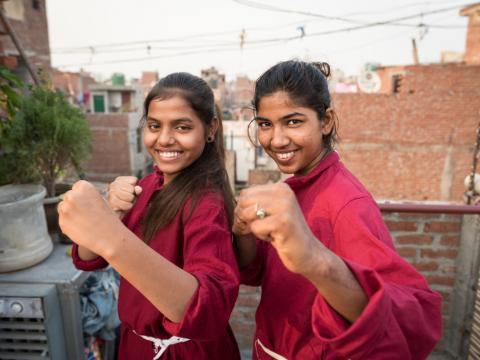What does success look like in urban areas? Grandmothers practising martial arts, of course!

On my first visit to a vibrant city like Delhi I expected a few surprises, but a grandmother practicing martial arts with a baby in her arms wasn’t one of them. I was in the Indian city to review our Citywide Self-Sustaining Model, an integrated approach to urban programming that aims to maximise World Vision's contribution to large scale, sustained impact in the lives of the most vulnerable children.
Our office in India is heavily invested in urban programming right across the country. In Delhi our focus is on creating ‘a safer city’; a response to the high crime rate and violence affecting children and women, especially those in slums and poor settlements.
As part of my visit I was treated to a performance by hundreds of girls showing off their self-defence skills. This was part of a project to empower girls to defend themselves if attacked. This was impressive in and of itself, but, a little like when the peacock fans its tail, it’s only when you see the total picture that you realise how special the complete package is. The martial arts classes were only one output of a partnership project that has also resulted in many additional benefits for everyone involved.
The Citywide Self-Sustaining Model, aimed to identify and include the most vulnerable children and groups; build coalitions and partnerships for citywide scale, be highly effective and create impact that would contribute to global and national discourse on urban policy. The more I studied this project in Delhi, the more I could see evidence that most of these aims were fulfilled.
The Police and the Department of Education were said to have learned a great deal about the issues of urban violence in their city by engaging with the most vulnerable children and by working with them to find solutions to the problems of violence. Also, trust was built up between the police and children who learned what legal protection they could expect from officers. This also meant young people felt able to approach officers to report a crime and call for the cases to be prosecuted.
Partnership must be at the heart of any citywide model and World Vision played a strategic role as facilitator and convener bringing together those in Delhi with an interest in seeing violence against children and women reduced. These included government bodies, faith organisations, schools and law enforcement. Indeed, it was only because a faith group agreed to provide space for free that the training could happen. This was important because space is contested in urban environments, especially overcrowded and dense cities like Delhi. Effective urban development projects must always seek to find and leverage available space—whether public or private.
The project also empowered young people to be active partners in recommending the project to police, leaders and families in other areas of the city. The more young people spoke up in support of the self-defence classes, the more classes were started. Once the Department of Education agreed to implement the self-defence training in 485 schools across the city, Delhi took a major step closer to meeting one of the four domains of change of the Cities for Children Framework: being a Safer City for children.
But perhaps the biggest ‘win’ of the model was illustrated by the grandmother who cradled her grandchild while, at the same time, demonstrating her recently acquired martial arts skills. This older woman’s involvement illustrated that the project was now reaching women of all ages—it had grown beyond its initial scope. The fact she had persuaded her five daughters-in-law to also take part in the self-defence training showed that women were ‘selling’ the project to other women - this Citywide Self-Sustaining Model had indeed become self-sustaining.